Case Study: Mitigating DDoS Attacks on WordPress E-Commerce Sites
Introduction
DDoS (Distributed Denial of Service) attacks pose a significant threat to WordPress e-commerce sites by overwhelming them with traffic from multiple sources, leading to downtime and potential financial losses. This case study outlines strategies for mitigating such attacks.
Strategies for Mitigation
1. Use a Web Application Firewall (WAF)
- Functionality: A WAF acts as a gatekeeper, inspecting incoming traffic and blocking malicious requests before they reach your server.
- Implementation: Choose a WAF solution that offers DDoS mitigation capabilities. This can be integrated with your hosting provider or through third-party services.
2. Implement DDoS Protection Services
- Cloudflare: Utilize services like Cloudflare, which can intercept and neutralize DDoS attacks before they reach your server. Cloudflare's free tier provides basic protection, though it may have limitations for large-scale attacks.
- Bot Protection: Use bot protection features to differentiate between friendly and malicious bots, ensuring essential services like uptime monitors and search engine crawlers are not blocked.
3. Utilize a Content Delivery Network (CDN)
- Functionality: A CDN distributes your website content across multiple servers worldwide, reducing the load on your server and absorbing some malicious traffic during a DDoS attack.
- Benefits: Look for a CDN provider with an anycast network to diffuse malicious traffic across multiple locations.
4. Security Plugins and Updates
- Plugin Selection: Install security plugins that offer real-time threat detection and IP blocking. Premium plugins often provide more comprehensive features.
- WordPress Updates: Keep WordPress and its plugins updated to patch vulnerabilities that attackers might exploit.
5. Proactive Measures
- Disable Unused Features: Disable features like XML-RPC, pingbacks, and trackbacks if not needed.
- Two-Factor Authentication: Implement two-factor authentication to protect login attempts.
- Verified Visitors: Consider using tools like Verified Visitors to verify user authenticity and prevent credential stuffing attacks.
Example Case Study
A small WordPress e-commerce site faced a DDoS attack that overwhelmed its server with traffic. To mitigate this:
- Immediate Action: The site was moved behind Cloudflare to utilize its DDoS protection capabilities.
- Long-term Measures: A WAF was set up to filter incoming traffic, and a CDN was implemented to distribute content and reduce server load.
- Security Enhancements: Security plugins were installed to monitor and block malicious traffic, and WordPress was kept updated to prevent exploitation of vulnerabilities.
Conclusion
Mitigating DDoS attacks on WordPress e-commerce sites requires a multi-layered approach involving WAFs, DDoS protection services, CDNs, security plugins, and proactive measures like disabling unused features and implementing two-factor authentication. By combining these strategies, sites can significantly reduce their vulnerability to DDoS attacks and maintain operational continuity.




















WebSeoSG offers the highest quality website traffic services in Singapore. We provide a variety of traffic services for our clients, including website traffic, desktop traffic, mobile traffic, Google traffic, search traffic, eCommerce traffic, YouTube traffic, and TikTok traffic. Our website boasts a 100% customer satisfaction rate, so you can confidently purchase large amounts of SEO traffic online. For just 40 SGD per month, you can immediately increase website traffic, improve SEO performance, and boost sales!
Having trouble choosing a traffic package? Contact us, and our staff will assist you.
Free consultation